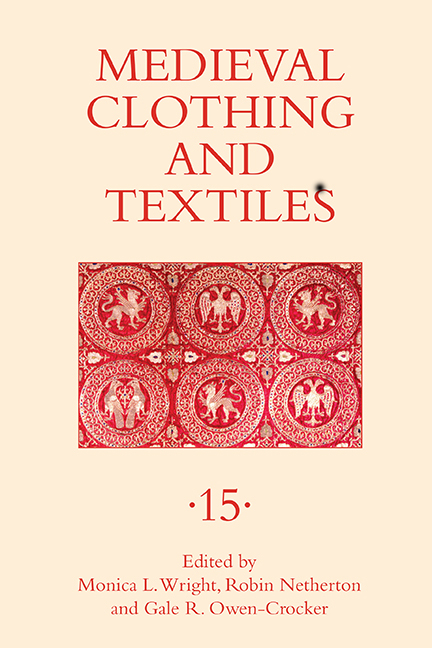Book contents
- Frontmatter
- Contents
- Illustrations
- Tables
- Contributors
- Preface
- 1 Old Rags, New Responses: Medieval Dress and Textiles
- 2 Text/Textile: “Wordweaving” in the Literatures of Anglo-Saxon England
- 3 Unfolding Identities: The Intertextual Roles of Clothing in the Nibelungenlied and Völsunga Saga
- 4 Clothing and Textiles at the Court of King John of England, 1199–1216
- 5 Dressing the Sacred: Medallion Silks and Their Use in Western Medieval Europe
- 6 Habit Envy: Extra-Religious Groups, Attire, and the Search for Legitimation Outside the Institutionalised Religious Orders
- 7 The Loom, the Lady, and Her Family Chapels: Weaving Identity in Late Medieval Art
- Recent Books of Interest
- Contents of Previous Volumes
Recent Books of Interest
Published online by Cambridge University Press: 31 March 2021
- Frontmatter
- Contents
- Illustrations
- Tables
- Contributors
- Preface
- 1 Old Rags, New Responses: Medieval Dress and Textiles
- 2 Text/Textile: “Wordweaving” in the Literatures of Anglo-Saxon England
- 3 Unfolding Identities: The Intertextual Roles of Clothing in the Nibelungenlied and Völsunga Saga
- 4 Clothing and Textiles at the Court of King John of England, 1199–1216
- 5 Dressing the Sacred: Medallion Silks and Their Use in Western Medieval Europe
- 6 Habit Envy: Extra-Religious Groups, Attire, and the Search for Legitimation Outside the Institutionalised Religious Orders
- 7 The Loom, the Lady, and Her Family Chapels: Weaving Identity in Late Medieval Art
- Recent Books of Interest
- Contents of Previous Volumes
Summary
L’Arte del Sarto nel Medioevo: Quando la Moda Diventa un Mestiere, by Elisa Tosi Brandi (Bologna: Il Mulino, 2017). ISBN 978-8815253248. 224 pages, 8 black-andwhite illustrations.
Elisa Tosi Brandi's book on the trade or art of the tailor in the Middle Ages is subtitled “when fashion became a profession,” alluding to the rise of tailoring as a specialist activity during this period. The material runs from the thirteenth to the sixteenth century and concentrates geographically on cities and towns in central and northern Italy, primarily Bologna, but also Udine, Verona, Milan, Venice, Ferrara, Rimini, Pisa, and L’Aquila.
This is a richly documented book, and the reader could spend happy hours following up the information provided in the footnotes. Chapter 1 begins with a reminder that the profession of tailor, one who cut and stitched clothing for both men and women, goes back to the Middle Ages and that it was a profession that responded to new needs in the courtly culture of the period, needs that were then disseminated through the city communes of Italy. This is followed in Chapter 2 by a focus on tailors within guild regulations, the ways in which the profession became specialized, and the work of women. Chapter 3 is concerned with the practicalities of the profession, such as places of work, tools, and the charges tailors were able to make for their work. It contains a very useful appendix on tariffs in various cities between the thirteenth and fifteenth centuries. The final chapter touches on a wide range of information: the relationship between tailor and client, the tailor in sixteenth-century treatises, fashion plates and manuals, records of clothing affected by sumptuary legislation.
L’Arte del Sarto is the result of a considerable amount of research and is also a wonderfully engaging read. Tosi Brandi has succeeded in bringing together a vast range of material, which she deftly manages, moving between primary and secondary sources with a light but sure touch.
Like many books published in Italy, L’Arte del Sarto does not contain a bibliography or an index. On the plus side, the lack of an index forces the reader to engage with the argument rather than cherry-pick specific topics.
- Type
- Chapter
- Information
- Medieval Clothing and Textiles 15 , pp. 183 - 196Publisher: Boydell & BrewerPrint publication year: 2019

